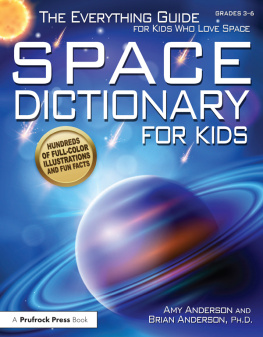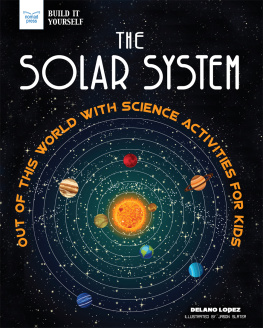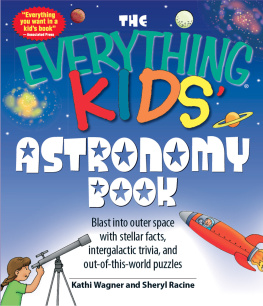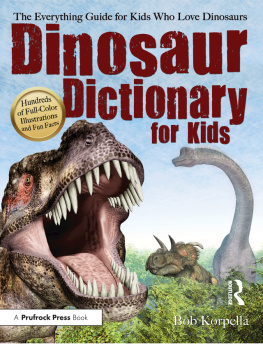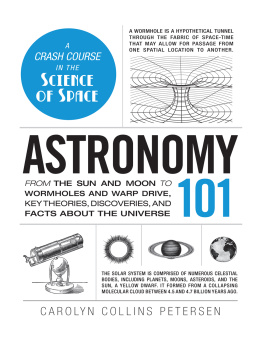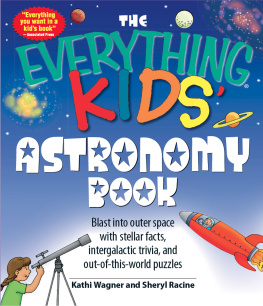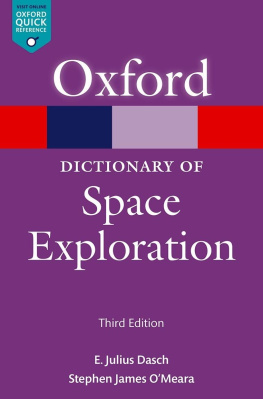DOI: 10.4324/9781003238096-1
If youre anything like us, youre fascinated by spacefrom stars, galaxies, and nebulas to black holes and supernovaseven the possibility that while were searching our skies for signs of alien life, someoneor somethingon some alien planet is searching their skies for us. More than any other branch of science, astronomy amazes us with both facts and possibilities. But in any area of science, a solid grasp of the vocabulary is essential for understanding the concepts. Whats the difference between a nova and a supernova? And what exactly is a quasar, anyway?
Of course theres a lot more to astronomy than just knowing what the words mean, and Space Dictionary for Kids is more than just a list of definitions. In addition to defining the vocabulary of astronomy, this book provides a deeper understanding of the concepts so that the definitions make sense. If weve done our job right, this book will not only answer many of the questions you have about space, itll also have you asking new questions that you never considered before.
Astronomy is too vast of a subject to take on all at once, so we have broken this dictionary into four sections. Cosmology deals with the origin and evolution of the universe. The section on Stars and Galaxies contains the vocabulary of deep space astronomyeverything outside of our solar system. The largest section of the book defines words that describe the objects in Earths immediate neighborhood, The Solar System. This is followed by a section on Astrobiology and Exoplanets, which covers two of the hottest topics in astronomy todaythe search for alien life in outer space and the study of planets orbiting other stars. Following the dictionary entries are a section on the history of space exploration, which outlines humankinds attempts to reach out into space; a timeline of astronomy through the ages; and a list of some books and websites that you may find useful in developing a deeper understanding and appreciation of astronomy.
Its our universelove it and learn itor leave it!
DOI: 10.4324/9781003238096-2
To ancient astronomers, the night sky was populated with eternal, unchanging stars, along with five planets that wandered among the stars, and occasional unexplained bright spots or streaks of light. As far as they could tell, the universe had always been that way and always would be. But as the science of astronomy developed, discoveries suggested that the universe has not always been the way it is now. The new finds suggested that the universe had a beginning and would one day come to an end, and that the universe and everything in it is constantly changing.
Astronomers now believe that the entire universe was once a tiny specka gigantic amount of matter contained in a region of space so small it would be impossible to measure. About 13.7 billion years ago that speck exploded from within. It expanded outward in every direction and formed the universe we know today. We call that explosion the Big Bang.
If youve ever set off a firecracker, youve seen the evidence it leaves behind. There are scattered pieces of paper from the shredded fi recracker and a bu rn mark on the ground where it went off. Immediately after the explosion theres a lingering odor in the air from the burnt gunpowder. In the same way, the Big Bang left clues behind to tell us that something had happened. We can plot the movements of the stars and galaxies in the universe and see that the universe is expanding. We can compare the compositions of new stars and old stars and see how the universe today has changed from its earliest form. And we can detect energy waves, called cosmic background radiation, that are found throughout the universe and indicate that the universe is still cooling down from its early rapid expansion.
Cosmology is the science of piecing together the clues to figure out how the universe began, how it came to be the way it is today, and what ultimate fate awaits the universe. These are some of the terms cosmologists use when studying the universe.
ABSOLUTE ZERO : The coldest possible temperature. At this temperature all molecular motion stops. Absolute zero is -460F (-273C), or 0 on the Kelvin temperature scale. Nothing ever reaches absolute zero, but interstellar space gets down to about 2.7 kelvins (-455F).
ACCELERATING UNIVERSE : The universe is expanding, and the farther you get from Earth the faster it seems to be expandingobjects that are farther away from Earth are moving away from us faster than objects that are closer to us are. This means the universe is an accelerating universe, in which some unknown force is pushing the universe apart more strongly than gravity is pulling everything together. We call that unknown force dark energy.
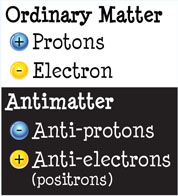
ANTIMATTER : The universe is made up almost entirely of ordinary matter, in which protons have a positive electrical charge and electrons have a negative charge. Antimatter particles are exactly like ordinary matter except that they have the opposite electrical charge: Anti-protons are negative and anti-electrons (positrons) are positive.

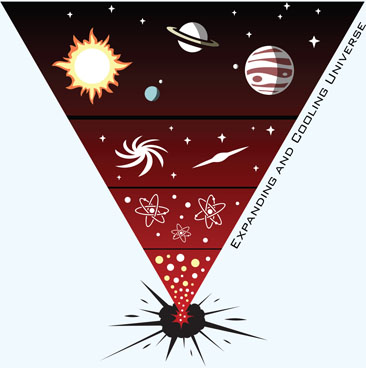
BIG BANG : A widely accepted theory in astronomy for how the universe began. According to the Big Bang theory, the entire universe was crammed into an infinitesimally small point that suddenly expanded outward like an inflating balloon about 13.7 billion years ago, and continues to expand today. The chaotic mix of energy and tiny subatomic particles coming off of the initial explosion slowly cooled and came together as protons, neutrons, and electrons, which formed the simplest atoms. Gravity pulled the atoms together to form massive clouds in space, and from there the first stars and galaxies were born.
COSMIC ABUNDANCE : After the Big Bang, nearly all of the atoms in the universe were hydrogen and helium, but fusion in stars has created many heavier atoms as well. When astronomers talk about the cosmic abundance of elements, theyre talking about how common one type of atom is compared to the others. For example, for every one million hydrogen atoms in an average star like our sun, there are about 98,000 helium atoms, 360 carbon atoms, 110 nitrogen atoms, and 850 oxygen atoms, along with lesser numbers of other elements.

COSMIC MICROWAVE BACKGROUND : The universe is filled with low-energy radiation that doesnt seem to have any particular source, and is found everywhere in space. This is called the cosmic microwave background, or CMB. Astronomers believe this is a sign that the universe is still cooling off after the Big Bang. The CMB is sometimes called the primal glow.
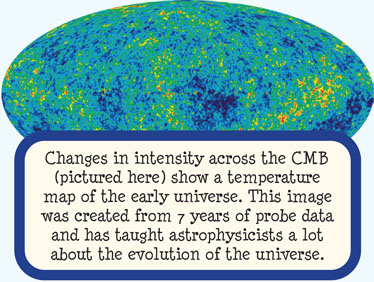
COSMIC RAY : Very high speed protons shooting through space. Some cosmic rays come from the sun, but most come from outside of our solar system, most likely from supernovas or active galactic nuclei. Most cosmic rays are deflected by the Earths magnetic field or are absorbed by the atmosphere.
COSMOLOGICAL PRINCIPLE : The universe looks more or less the same in every direction from Earth. The cosmological principle is the idea that the universe is pretty much the same everywhere, and that the parts of the universe we cant see look a lot like the parts we can see.

